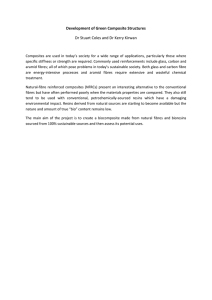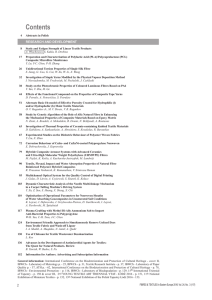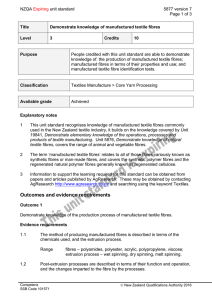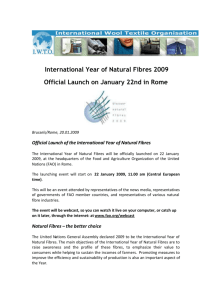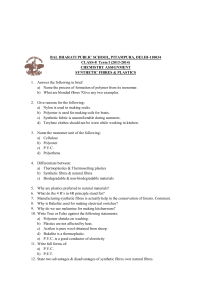NZQA unit standard 5876 version 7
advertisement
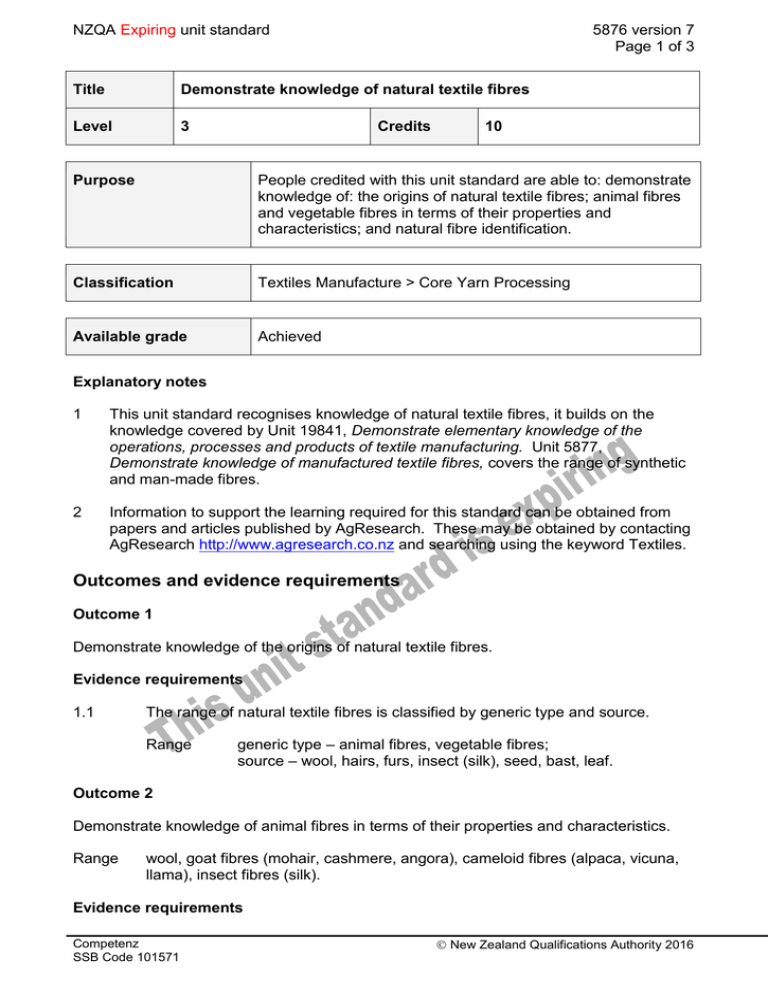
NZQA Expiring unit standard 5876 version 7 Page 1 of 3 Title Demonstrate knowledge of natural textile fibres Level 3 Credits 10 Purpose People credited with this unit standard are able to: demonstrate knowledge of: the origins of natural textile fibres; animal fibres and vegetable fibres in terms of their properties and characteristics; and natural fibre identification. Classification Textiles Manufacture > Core Yarn Processing Available grade Achieved Explanatory notes 1 This unit standard recognises knowledge of natural textile fibres, it builds on the knowledge covered by Unit 19841, Demonstrate elementary knowledge of the operations, processes and products of textile manufacturing. Unit 5877, Demonstrate knowledge of manufactured textile fibres, covers the range of synthetic and man-made fibres. 2 Information to support the learning required for this standard can be obtained from papers and articles published by AgResearch. These may be obtained by contacting AgResearch http://www.agresearch.co.nz and searching using the keyword Textiles. Outcomes and evidence requirements Outcome 1 Demonstrate knowledge of the origins of natural textile fibres. Evidence requirements 1.1 The range of natural textile fibres is classified by generic type and source. Range generic type – animal fibres, vegetable fibres; source – wool, hairs, furs, insect (silk), seed, bast, leaf. Outcome 2 Demonstrate knowledge of animal fibres in terms of their properties and characteristics. Range wool, goat fibres (mohair, cashmere, angora), cameloid fibres (alpaca, vicuna, llama), insect fibres (silk). Evidence requirements Competenz SSB Code 101571 New Zealand Qualifications Authority 2016 NZQA Expiring unit standard 2.1 The principal animal fibres are described and compared in terms of their elementary characteristics. Range 2.2 5876 version 7 Page 2 of 3 characteristics – animal breed, fibre fineness, fibre length, crimp and scale structure for wools and hairs, fibre formation of silk. The principal animal fibres are described and compared in terms of their properties and textile end uses. Range properties – strength and elasticity, moisture absorbency and regain, thermal properties, dye affinity, reaction to chemicals; end uses – two end uses that illustrate the typical textile use of the fibre. Outcome 3 Demonstrate knowledge of vegetable fibres in terms of their properties and characteristics. Range cotton, linen, jute, ramie. Evidence requirements 3.1 The principal vegetable fibres are described and compared in terms of their elementary characteristics. Range 3.2 characteristics – types (for cotton), fibre fineness, fibre length, fibre structure. The principal vegetable fibres are described and compared in terms of their properties and textile end uses. Range properties – strength and elasticity, moisture absorbency and regain, thermal properties, dye affinity, reaction to chemicals; end uses – two end uses that illustrate the typical textile use of the fibre. Outcome 4 Demonstrate knowledge of natural fibre identification. Evidence requirements 4.1 Tests used to identify natural textile fibres are described in terms of the way the test is carried out and the characteristic results for each natural fibre. Range Competenz SSB Code 101571 fibres – wool, cotton, cashmere, mohair, linen, jute; tests – visual, chemical, physical. New Zealand Qualifications Authority 2016 NZQA Expiring unit standard Replacement information 5876 version 7 Page 3 of 3 This unit standard and unit standard 5877 have been replaced by unit standard 29448. This unit standard is expiring. Assessment against the standard must take place by the last date for assessment set out below. Status information and last date for assessment for superseded versions Process Version Date Last Date for Assessment Registration 1 20 December 1995 31 December 2019 Revision 2 8 August 1997 31 December 2019 Revision 3 18 July 2000 31 December 2019 Revision 4 10 October 2001 31 December 2019 Revision 5 11 December 2003 31 December 2019 Review 6 23 April 2008 31 December 2019 Review 7 19 May 2016 31 December 2019 Consent and Moderation Requirements (CMR) reference 0030 This CMR can be accessed at http://www.nzqa.govt.nz/framework/search/index.do. Please note Providers must be granted consent to assess against standards (accredited) by NZQA, before they can report credits from assessment against unit standards or deliver courses of study leading to that assessment. Industry Training Organisations must be granted consent to assess against standards by NZQA before they can register credits from assessment against unit standards. Providers and Industry Training Organisations, which have been granted consent and which are assessing against unit standards must engage with the moderation system that applies to those standards. Requirements for consent to assess and an outline of the moderation system that applies to this standard are outlined in the Consent and Moderation Requirements (CMR). The CMR also includes useful information about special requirements for organisations wishing to develop education and training programmes, such as minimum qualifications for tutors and assessors, and special resource requirements. Competenz SSB Code 101571 New Zealand Qualifications Authority 2016
